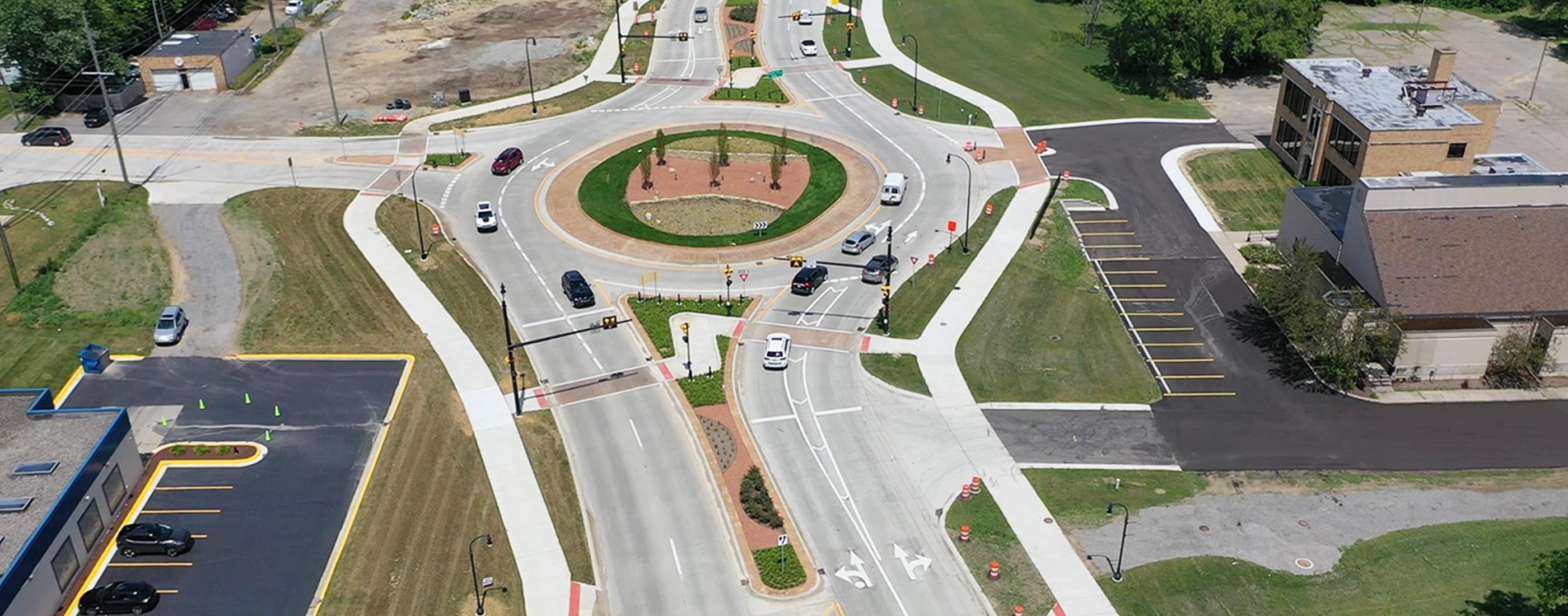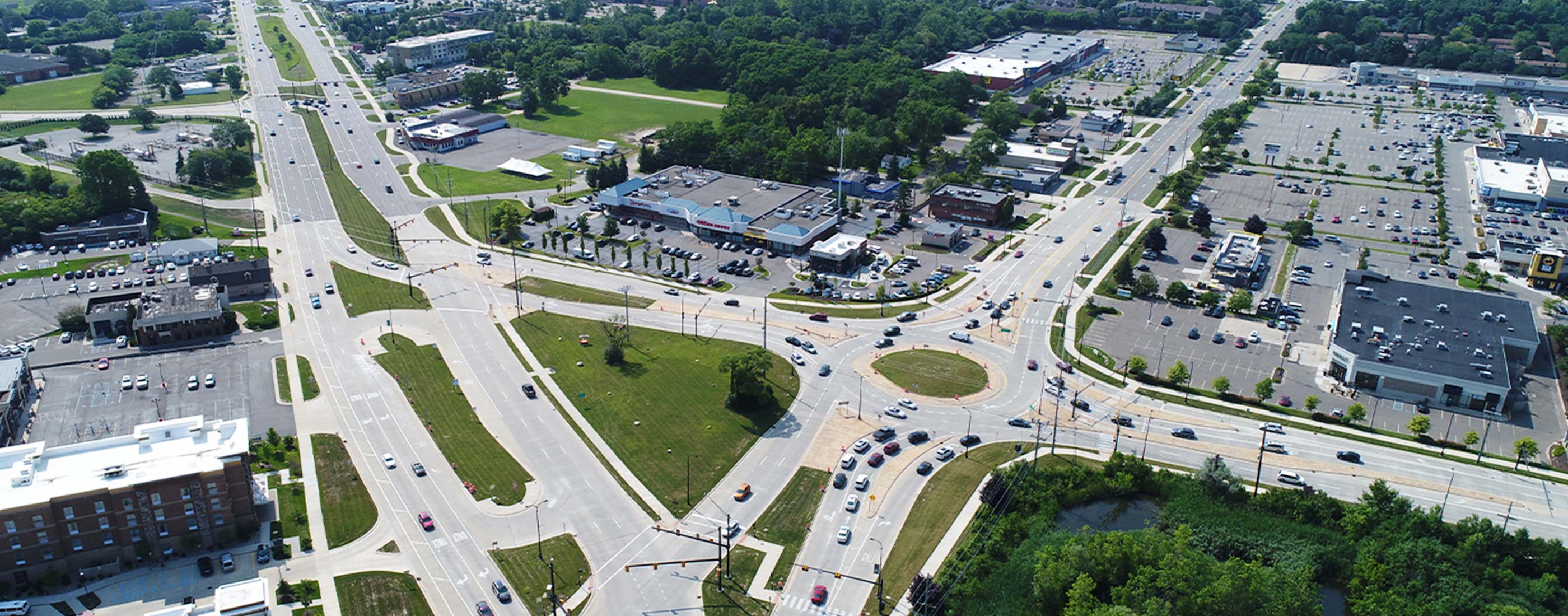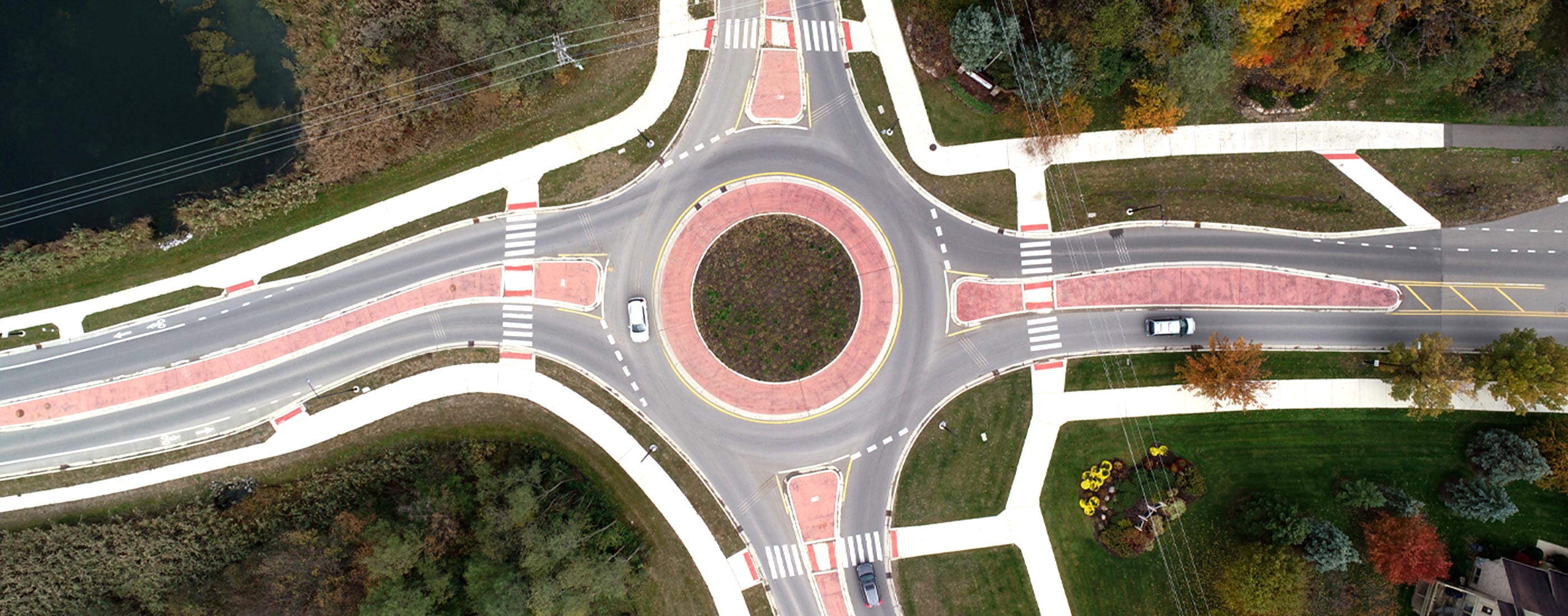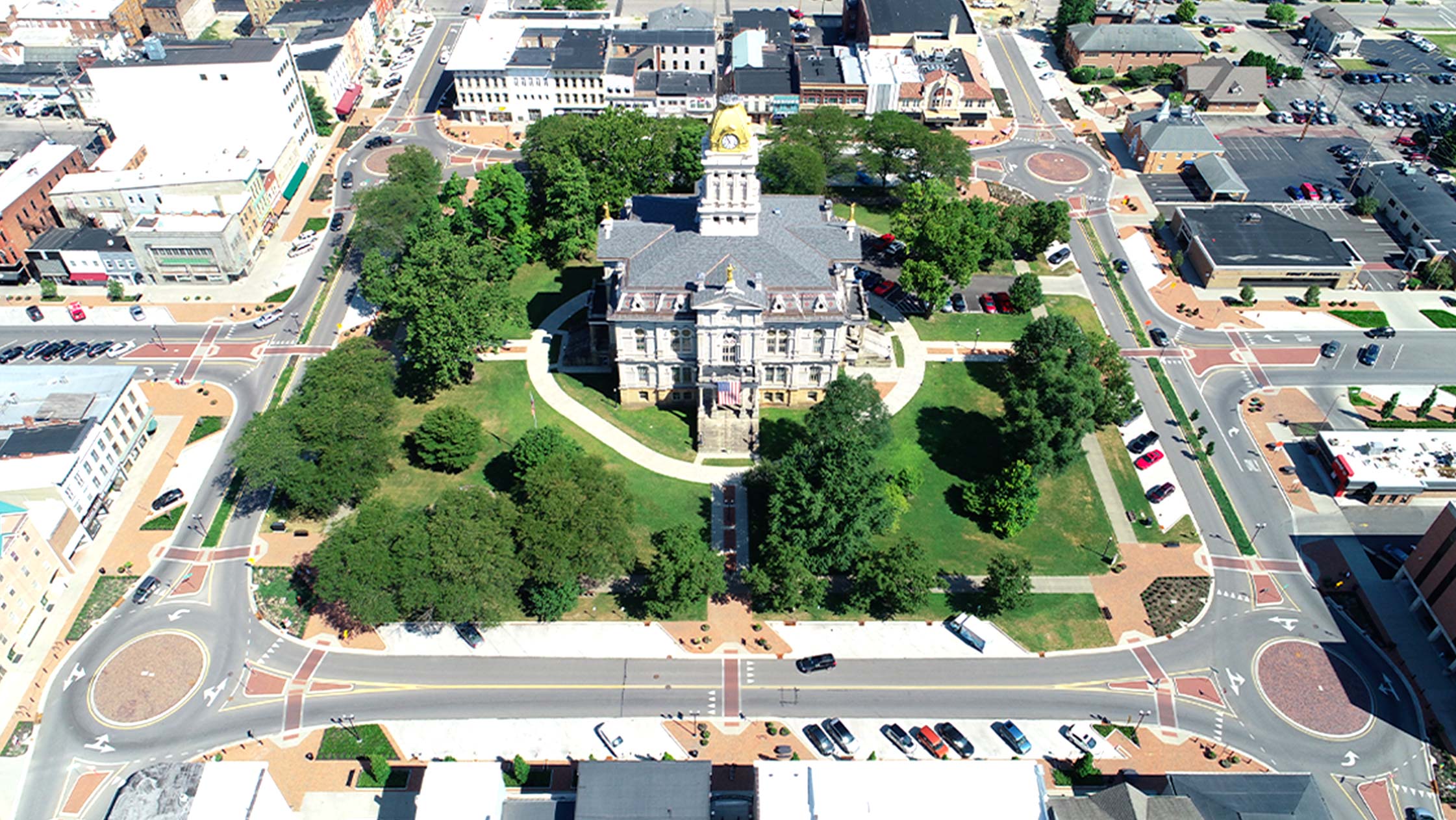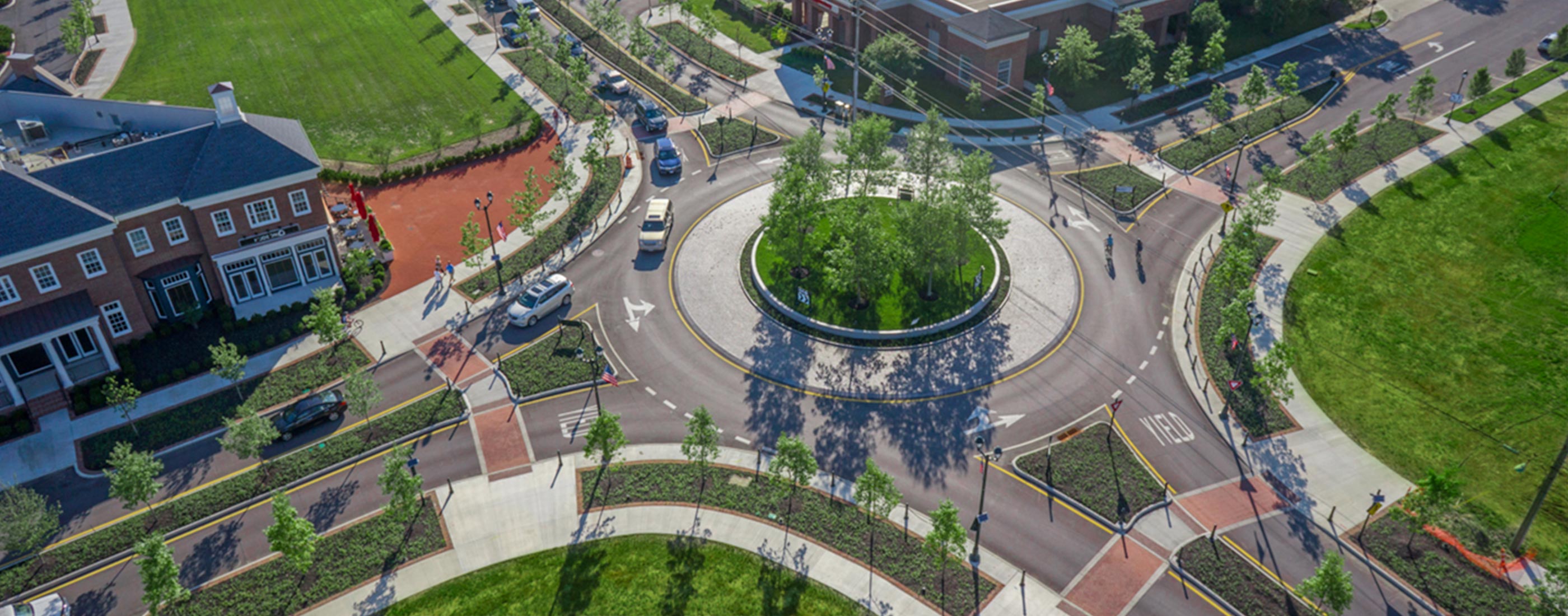Roundabout Design: Theory and Practice
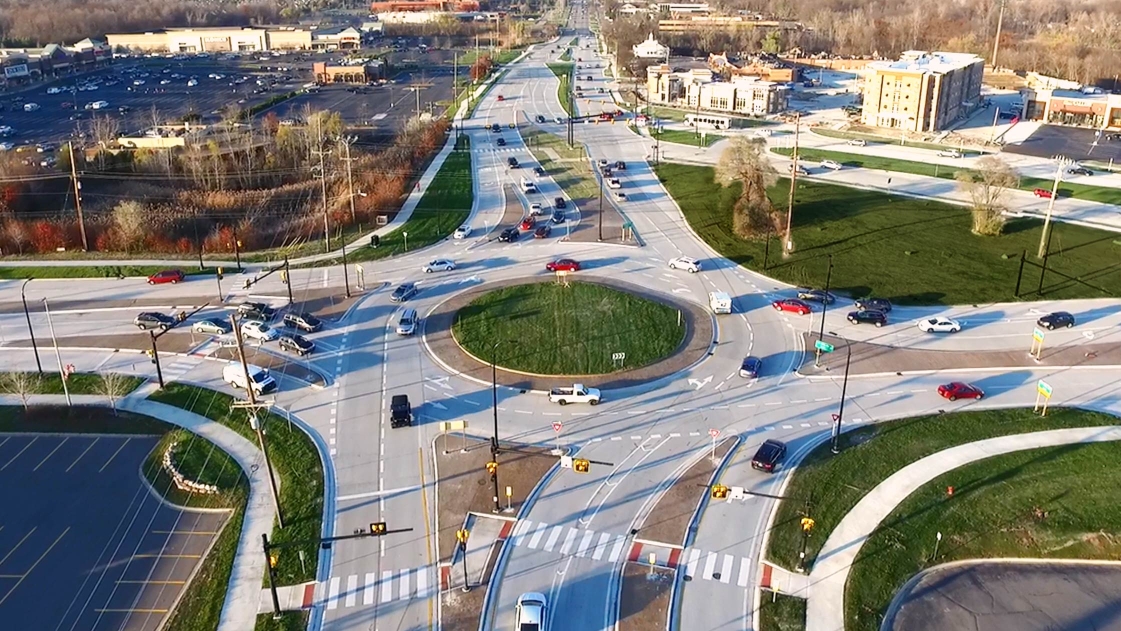
Roundabout designs for all types of roads are coming to life throughout the country. Whether communities are implementing them on heavily congested, multi-lane thoroughfares or in urban areas with fewer traffic lanes accommodating multimodal travelers, roundabouts are becoming a prevalent transportation solution.
And for good reason. Although navigating a new roundabout might take some getting used to, the benefits for everyone are measurable. We should know—our transportation engineers and planners have designed dozens of roundabouts for our clients, including multi-lane roundabouts in heavily traveled transportation corridors and single-lane roundabouts in urban settings.
Here’s a look at some of benefits the addition of a roundabout can bring to communities—including a few things you may not have considered—and how they’ve come to life in a sampling of client communities we’ve worked with in the past two decades.
Benefits of Roundabouts
Communities around the country today are dealing with myriad roadway infrastructure challenges. Not only are they trying to fix Infrastructure Report Grade D roads whose maintenance has always been difficult to keep up with, but they’re trying to accommodate ever-changing development patterns and population shifts and the traffic pattern changes that come with them. Not to mention the safety considerations that a slew of multimodal users brings to the design table. And the considerations that exist as we navigate the future of climate change and big weather events. And, of course, the funding challenges to pull the projects off.
In a word, it’s a lot.
Roundabouts are adaptable solutions that can work for most types of roads—from heavily-trafficked multi-lane roads to single-lane roads in urban downtowns—and implementing them in community road projects can go a long way to helping solve some of these challenges. Roundabouts’ many benefits include (among a long list of others!):
- Reduced congestion: Both multi-lane and single-lane roundabouts alleviate congestion by allowing continuous vehicle movement in lieu of traffic signals and a continuous flow for the traffic pattern.
- Increased safety: Roundabouts are proven to reduce the incidence of severe and fatal vehicle accidents due to their speed reduction and traffic calming properties, leading to a current trend of implementing “mini” roundabouts in pedestrian, multimodal urban areas across the country.
- Cost savings: Although research shows that the cost of implementing a roundabout is about the same as implementing a traffic signal in the same location, roundabouts are less costly over time to operate and maintain and do not require large capital outlays for major repair, allowing communities to make better informed asset management decisions.
- Increased resiliency: In times of crisis due to fire, flooding, or other climate-induced or non-climate induced situations, a non-signalized roundabout remains standing. There’s no power outage to deal with and no confusion and inconvenience related to traffic congestion delays.
- Increased sustainability: Roundabouts don’t stress the local power grid, often include green stormwater management features in their medians and reduce emissions from vehicles idling at traffic signals.
Case Studies
Roundabouts on Major Roadways with Multiple Lanes
The multi-year, $30+ million Baldwin Road Reconstruction project transforms a 3-mile roadway corridor bearing nearly 30,000 vehicles per day communing traffic to and from a major Michigan interstate. The design plan included a widened boulevard with five multi-lane roundabouts around the built and natural environment, which required varying roadway elevation changes, nearly 100 parcel impacts, several miles of underground and overhead utility relocations with limited space, and nearly two miles of water main replacement. It will improve direct access for businesses, accommodate multimodal transportation, enhance traffic safety and greatly reduce years-long daily congestion and delay.
The $50M+ Northwestern Connector project near Detroit started in 2003 as a complex road reconfiguration to rectify an onerous traffic congestion and safety situation resulting from decades of population growth and development that had led to nearly 100,000 vehicles per day creating a significant regional transportation bottleneck. The design solution created three closely spaced, high-volume intersections—one of which included a multi-lane roundabout—plus the reconfiguration of 1.3 miles of roadway. Decades-long congestion has been significantly reduced, and traffic flows safely on a reimagined thoroughfare through a vital community crossroads.
Roundabouts in Pedestrian Areas with Single Lanes
The City of Ann Arbor, Michigan sought a roundabout design at the highly traveled intersection of Nixon, Green and Dhu Varren roads to streamline travel and increase safety for drivers, cyclists and pedestrians. We created a design aligning the two offset “tee” intersections with a single-lane roundabout to maximize safety and traffic flow in the area and included wetland mitigation and green landscape architecture elements.
The City of Newark, Ohio turned a substantial downtown sewer renovation project into a major area revitalization in order to address worsening issues with chaotic traffic circulation, unsafe pedestrian crossing conditions, insufficient surface parking and deteriorating streetscapes. Our multidisciplinary team of experts designed a comprehensive vision plan that included redesign of the traffic pattern around the city’s the hundred-year-old town square, incorporating four “mini” roundabouts at its corners that drastically improved circulation, calmed traffic flow and facilitated walkability.
Our team was engaged to identify the best solution to upgrade an existing intersection in the heart of the City of New Albany, Ohio by comparing a traditional signalized intersection with a roundabout option. We completed an array of options to provide efficient traffic flow through the area, and the City chose our design for a 130’ diameter, single-lane roundabout that includes enhanced pedestrian crossings and incorporates parallel parking, landscaped medians, wide sidewalks and tree boxes within the intersecting streetscape. The roundabout acts as a “gateway” feature for the downtown and has significantly increased safety for multimodal travelers.
Our Transportation and Planning teams are busy working on more projects coming soon to our website. For more information on how they can help your community with the transportation solution for your situation, contact us today!
